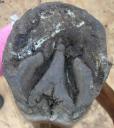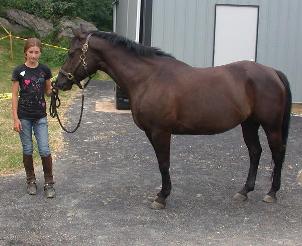OR POOR HOOF FORM?
The Morgan mare is believed to be about 15 yo. She was found at auction in MA. Due to her severe lameness (grade5/5 at a the walk), no one wanted her and for several weeks she wasted in the auction pens. She was shod, but according to the sellers it did not help, and even with Banamine she was completely lame on some days. She was in danger of getting picked up by a slaughter-bound truck when by chance the current owner found her and purchased her for $400.
(Click on thumbnails for larger views).


Left Hind AP Left Hind Lateral
This horse clearly has a very advanced case of high, apparently articular, ringbone. According to the veterinary diagnosis, it was the most severe case ever seen by that vet and the horse would never be sound for riding.



Left Hind
The ringbone is clearly visible even without radiographs and the mare frequently favored the Left Hind.
Moving on from what is visible on radiographs, the obvious confronts the viewer: the horse’s hoof form is terrible and overgrown, the result of neglect or ignorance. There is certainly more than enough cause here for lameness of some degree.



LH before, fig. 1 LH before, fig. 2 LH after, fig. 3
The bars on the Left Hind are clearly overgrown to the point where they are actually above not only the level of the sole but the wall as well, meaning the bar would be the first structure to bear the horse’s weight, upon weightbearing rather than the walls and sole. Since the foot is somewhat contracted and the wall and bar material are very hard (as is typical in Morgans), the bars are not folding over onto the sole, the effect for the horse being like stepping onto the dull edge of a knife with each step. No wonder she refused to put any weight onto that foot.
Fig. 1 shows the edge of the too-long bar (red arrow) as well as the desired location of the bar (blue dashed line). Fig. 2 shows the bar grown all the way around the apex of the frog (red arrows), also a source for pain. Fig. 3 shows the bars lowered and removed from the sole. After this trim the mare was much more willing to stand on this foot but was still lame on turns.
Having become more comfortable on the LH, she now exhibited more clearly lameness on the Right Front and is seen holding that foot behind her, a sign of pain.

Further investigation revealed deeply imbedded bar on the RF front, which when removed, produced immediate improved soundness.
Right Front


Before After


Before After
Update: The mare has been under the new owner’s care for about six months now. After her first few trims she was able to place weight on her feet and move comfortably, so she was started on trail rides of increasing duration, sometimes as much as 4 hours long. After the very longest rides she would show some signs of discomfort in her hind legs, which presumably was the articular deposits being worn away from the hours of movement. (This will be confirmed in the coming months with new X-rays). But evn this discomfort is no longer present. It is apparent that the obvious pain and inability to place weight on the Left Hind was orginating from the large overgrown bar seen from the underside on the lateral side of the foot, even though this was never observed in the lameness diagnosis. The lameness was all attributed to the ringbone. She requires no boots on every kind of footing in the park where she trail rides.






























